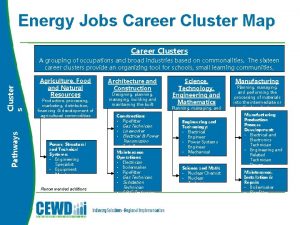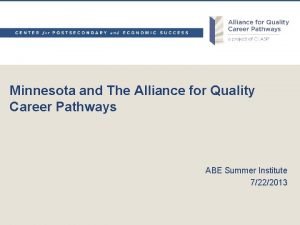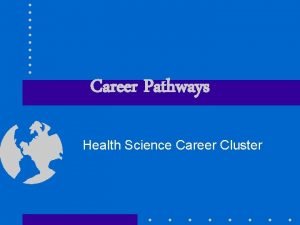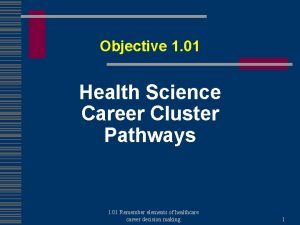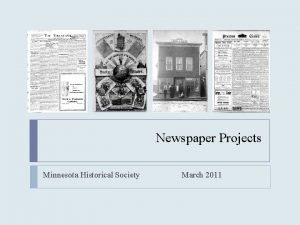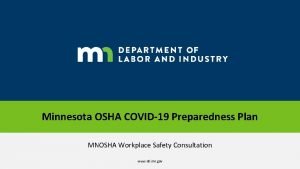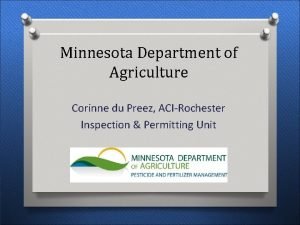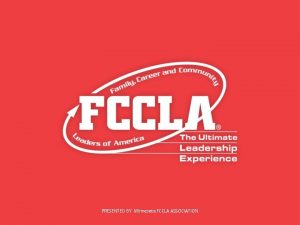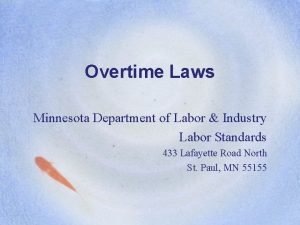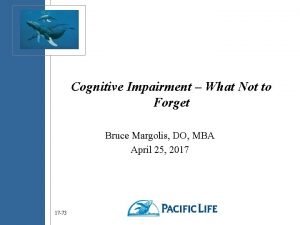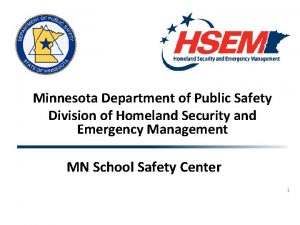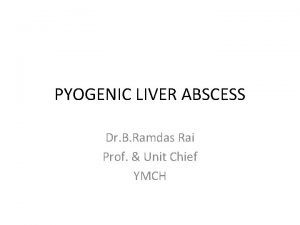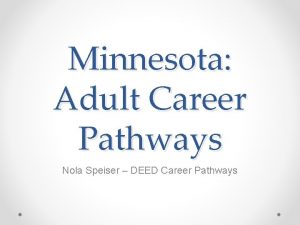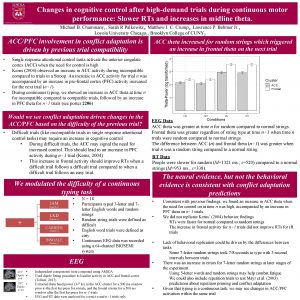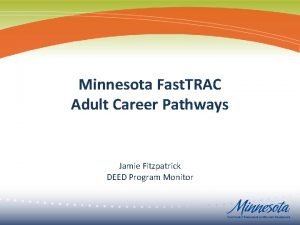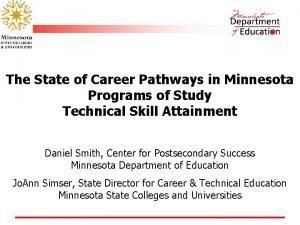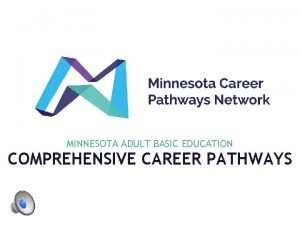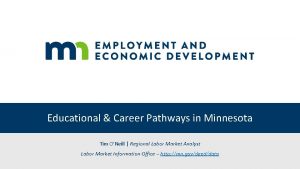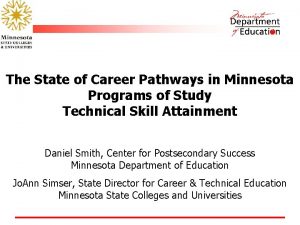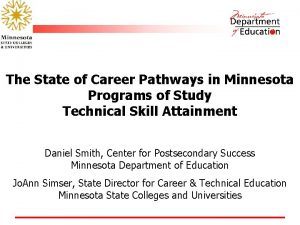HighSkill HighWage or HighDemand Career Pathways in Minnesota


















- Slides: 18

High-Skill, High-Wage, or High-Demand Career Pathways in Minnesota: A Step-by-Step Procedure that Links Student Credential Attainment to Employment Occupational Demand National Association of Career and Technical Education Information Boise Idaho May 22, 2008 Pradeep Kotamraju Bruce Steuernagel System Director, Labor Market Analyst Perkins Federal Grant Program Approval Unit pradeep. kotamraju@so. mnscu. edu bruce. steuernagel@so. mnscu. edu Academic and Student Affairs Office of the Chancellor Minnesota State Colleges and Universities www. mnscu. edu The Minnesota State Colleges and Universities System is an Equal Opportunity employer and educator.

Study Purpose and Presentation Outline • Using the Career Pathway Framework: – Using current Labor Market Information for ranking career pathway as In-Demand Career Pathways (IDCP) – Labor Market Information further analyzed at the pathway level to determine high-wage or high-demand or high-skill Slide 2

Study Purpose and Presentation Outline • Using the Career Pathway Framework: – Develop a Career Pathway Sustained Student Interest (CPSSI) Ranking Using Longitudinal (2003 -2007) Post. Secondary CTE Data on Concentrators – Match In-Demand Career Pathways (IDCP) Ranking to Career Pathway Sustained Student Interest (CPSSI) Ranking Slide 3

Study Purpose and Presentation Outline • Using the Career Pathway Framework: – Develop a Typology that Relates In. Demand Career Pathways (IDCP) to Career Pathway Sustained Student Interest (CPSSI) – Identify High-Wage or High Demand or High Skill Career Pathways in the Matched List of Career Pathways Slide 4

The 21 st Century Career and Technical Education Framework: The National Framework Perkins IV High School Reform Education and Employment Transitions American Competitiveness Slide 5 The Intent of Perkins IV jointly addresses the three prominent national education and workforce development policy issues facing the United States in the 21 st century

Minnesota State Colleges and Universities: General Information § The Minnesota State Colleges and Universities System comprises of: � 7 state universities, � 5 community colleges, � 7 technical colleges, and � 13 combined community and technical colleges Slide 6 In 2007, the Minnesota State Colleges and Universities System § Serves 382, 000 students annually in credit and non -credit courses § Educates 64% of the state’s undergraduates § Serves more students of color than any other higher education provider in Minnesota – almost 33, 000

Minnesota State Colleges and Universities: Graduate Information § 34, 000 graduates leave the system, annually, with some type of academic credential § Of the total graduates produced by Minnesota higher education each year, the system educates: - 52% of the teaching graduates - 82% of the state’s new nursing graduates - 89% of state’s law enforcement officers - 89% of the new graduates in construction trades - 41% of the state’s new business graduates - About 9, 000 firefighters and emergency first responders Slide 7

Minnesota State Colleges and Universities: Workforce Development Information § More than 82% of the graduates stay in Minnesota to work or continue their education § Place more than 88% of the graduates in jobs related to their field of study § Provide career education to 6, 000 employers and about 151, 000 employees each year § Return $10. 87 to the state’s economy for every $1 of net state appropriation Slide 8

Minnesota Career Fields, Clusters & Pathways Slide 9

Career Fields, Clusters, Specialties, and Program Majors: An Overlay of a Program of Study Framework Agriculture, Food & Natural Resources Health Science Technology Career Field Awarenes s Career Pathway Focus Business, Management & Administration Career Field Awarenes s High School: Level 9 – 10 Foundation & Career Field Career Pathway Focus High School: Level 11 -12 Career Cluster & Pathway Career Specialty Concentration Two-Year College: Level 13 -14 Career Pathway & Specialty University: Level 15 -16 Career Specialty & Program Major Slide 10

Study Methodology • Developing an IDCP Ranking: – Rank each element – • projected employment growth rate 2006 -2016 • projected total hires 2006 -2016 percent share of • the 2006 base employment • 25 th percentile hourly wage • current demand indicator rank • Sum Individual Ranks and re-rank sum • Lowest Sum indicates highest IDCP Slide 11

Study Methodology • Develop an CPSSI Ranking Using Longitudinal (2003 -2007) Post-Secondary CTE Data on Concentrator Success: – Concentrator definition based on Perkins IV • Three Entry-Cohorts (2003, 2004, 2005) • Success definition is sum of Graduation and Retention + Transfer • Success Rate definition is equal to: (Graduation + Retention+ Transfer)/Concentrator – Sum Individual Ranks of the three cohorts and re-rank sum – Lowest Sum indicates highest CPSSI Slide 12

Study Methodology • Match IDCP Ranking with CPSSI Ranking – Produce a graphical representation of the relationships between the two rankings – Classify into four groups: • High IDCP Rank / High CPSSI Rank • High IDCP Rank / Low CPSSI Rank • Low IDCP Rank / High CPSSI Rank • Low IDCP Rank / Low CPSSI Rank Produce a Pathway List Based on Above Four Groups Slide 13

Slide 14

Definition of High Wage or High-Skill or High-Demand Pathways v The Minnesota Department of Employment and Economic Development (DEED) definitions for what is High Wage, High Demand or High Skill: – High Wage: An occupation was determined to be High Wage if the median wage for the occupation was greater than $17. 21 – High Demand: An occupation was determined to be a High Demand occupation if the 2006 employment for the specific occupation: » Represented at least 0. 1% of 2006 total employment in all occupations (2, 961) and » the projected total openings for the specific occupation as a share of 2006 employment in the specific occupation was greater than the share of projected total openings to 2006 total employment for all occupations (31. 76%). Slide 15 The above criteria was applied at the Pathway level to define High Growth Pathways

Definition of High Wage or High-Skill or High-Demand Pathways v The Minnesota Department of Employment and Economic Development (DEED) definitions for what is High Wage, High Demand or High Skill: – High Skill: Using the DEED-LMI MN-adjusted education/training levels, the occupations selected for high skill have the following education/training levels: » » » » » Long-term on-the-job training Work experience in a related field Postsecondary vocational award Associate's degree Bachelor's degree Degree plus work experience Master's degree Doctoral degree First Professional degree The above criteria was applied at the Pathway level to define High Growth Pathways Slide 16

Observations, Considerations and Issues in Demand Supply Matching • Each of the Listed Groups Above Lead to Actionable Steps • Mixture of Industry and Occupation Focus Among and Within Pathways • Customization of Pathways • No Electronic Tool for Matching, Use Federal and State Labor Market Information (LMI) • Read Behind the Ranking to Understand What Might be Happening Within the Pathway • Ranking Sensitive to Choice of Ranking Components • Using Local Advisory Committees to Validate Regional and National LMI • Understand what it means to Look Forward by Looking Back Slide 17

Contact Information Pradeep Kotamraju Ph. D. System Director, Perkins Federal Grants Office of the Chancellor Minnesota State Colleges and Universities Wells Fargo Place 30 E. 7 th Street, Suite 350 St. Paul MN 55101 Tel No: 651 -282 -5569; Cell: 612 -701 -7561 Fax: 651 -296 -3214 www. cte. mnscu. edu Slide 18
 Wisconsin career pathways
Wisconsin career pathways Cyber career pathways tool
Cyber career pathways tool Energy career cluster definition
Energy career cluster definition Verizon career pathways
Verizon career pathways Quality career pathways
Quality career pathways Jobs in health science career cluster
Jobs in health science career cluster Health science career cluster jobs
Health science career cluster jobs Support services career pathway
Support services career pathway 16 national career clusters framework
16 national career clusters framework Formulas for career success
Formulas for career success Minnesota historical newspapers
Minnesota historical newspapers Mn osha consultation
Mn osha consultation Minnesota department of agriculture
Minnesota department of agriculture Minnesota fccla
Minnesota fccla Minnesota overtime law
Minnesota overtime law Bruce margolis
Bruce margolis Department of homeland security minnesota
Department of homeland security minnesota Eysenck personality questionnaire
Eysenck personality questionnaire Minnesota tube
Minnesota tube


